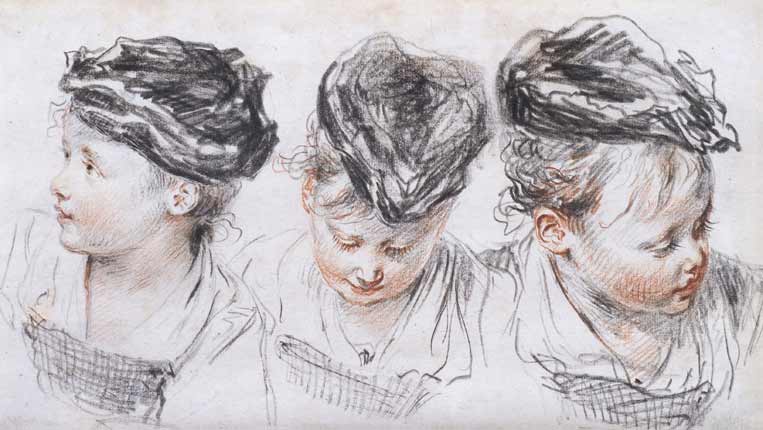Watteau: The Drawings, Royal Academy, London
Watteau epitomises the frivolity of 18th-century France, yet his drawings hint at the profound changes to come

It is difficult to look at early 18th-century French art without seeing the enormity that was to come; the dark shadow of the guillotine on Fragonard's rustling greenery, or grim Republican virtues in Greuze. And, of course, those things aren't there.
Jacques-Louis David, high priest of the Terror, wasn't born until 1748, when Antoine Watteau, recorder of the Old Regime, had been dead nearly 30 years. To work backwards from David's Roman dramas to the silken theatricality of Watteau's pierrots is unfair, like judging the paintings of Walter Sickert by those of Damien Hirst.
Still, that is what we tend to do. By the sombre lights of the 1790s, French art of the 1700s is appallingly frivolous – the outpouring of a decadent society in which aristocrats dallied at Versailles while peasants starved. Common sense and recent historiography tell us that this was not the whole story, but Watteau remains a symbol of ancien régime frivolity all the same, the mysteriousness of his painted fêtes galantes hiding a nasty secret. We look at Watteau and hold him responsible for what was to come, his work a cypher for that immoral luxury that would end with the storming of the Bastille.
And, to an extent, his art is luxurious. Louis XIV and his successors used Versailles as an instrument of control, a gilded prison in which the First Estate could be made to act out the rituals of court in a time-consuming ballet. Not for nothing were late 17th-century aristocrats obsessed with the new-fangled Italian commedia dell'arte depicted by Watteau: it resembled their own lives. In the midst of all this artificiality, artifice became a virtue. Where there was no privacy, secrecy was a luxury. Before, art had served a function – the reinforcement of dynasty in portraiture, of religious orthodoxy in pietistic pictures. Now it existed only for itself, as a marker of courtly taste. Where painting had been social and communicative, it became antisocial and secretive. Versailles called for, and got, an art of pointlessness.
And so with Watteau. His paintings are so compelling because they are so unknowable. What draws fashionable beaux and silken ladies to rustic groves? How did they get there? What is going on between that cupid and that herm? And if this concealment makes Watteau's paintings objets de luxe, it makes the drawings that led to those paintings more luxurious still: the secrets, as it were, behind the secrets.
Which brings us, at last, to Watteau: The Drawings at the Royal Academy, where 80 of those drawings are on show. That these fragile works on paper have survived for 300 years tells us something about them – that they were valued in themselves and not just as studies for paintings, that people collected and conserved them. The temptation is thus to see these gem-like objects as gems, treated with the reverence accorded to small and expensive things. That is a mistake.
If privacy was a luxury in aristocratic France, then it was because it allowed a space for sedition. Although we tend not to think of them in this way, Watteau's drawings are seditious – not politically, but aesthetically. Were it not for the unfortunate connotations of the word, we might almost call them revolutionary. In the privacy of these deeply private works, Watteau up-ends a moral order that had obtained for centuries.
French art, made for public consumption, had tended to concentrate on externalities. In his drawings, Watteau looks beneath the silks and satins to another world – a world of touch, in which the soft scratch of red, white and black chalk on grey paper becomes a metaphor for humanity. If you only have half an hour to see this show, then go straight to the room of nudes, in particular, to Semi-Nude Woman, Seated on a Day-bed, Holding Her Left Foot in Her Hands. Should the feel of this beautiful drawing seem familiar, then it is because it reminds us of another French artist, born more than a century after Watteau's death. That artist is Degas.
Words such as "Rococo" and "aristocratic" carry a moral weight; they have done Watteau no favours at all. His ravishing drawing The Remedy tells us a different story. A young woman, nude, lies in a classical pose as her maid attends to her. The object in the maid's left hand is a syringe. She is about to give her mistress an enema. Watteau has paid much more attention to the maid than to her lady, changing the position of her head three times. His interest is less in the classical than in the merely human. That same interest would lead to the revolution; an irony worth thinking about as you walk around this show.
To 5 Jun (020-7300 8000)
Next Week
Charles Darwent has a word in Picasso's eye, in Florence and in Amsterdam
Art choice
A visit to British Art Show 7, a five-yearly best-of-British touring art jamboree, is worth it for Christian Marclay’s captivating film The Clock, above, alone. Lose track of time at the Hayward, London (till 17 Apr, then on tour). Simon Starling: Recent History brings together previously unseen works by the Turner Prize-winner at Tate St Ives (to 2 May
Subscribe to Independent Premium to bookmark this article
Want to bookmark your favourite articles and stories to read or reference later? Start your Independent Premium subscription today.

Join our commenting forum
Join thought-provoking conversations, follow other Independent readers and see their replies